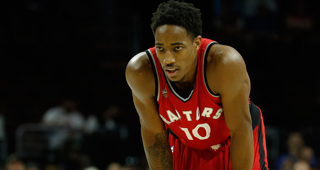While the regular season is a grueling slog that forces teams to think big picture, the NBA playoffs are a different beast. Each game becomes a chess match, where little strategic nuances can be the difference between success and failure. In these previews, we’ll take a look at one intriguing tactical quandary facing each team.
Toronto Raptors
- Jonas Valanciunas versus the team’s best lineup
If one clear outcome emerged from Toronto’s last series, it’s that this team operates better with a smaller, more athletic unit. In the 43 minutes where Norman Powell swapped spots with Valanciunas in the starting lineup, the Raptors outscored the Bucks by 17.7 points per 48 minutes, per NBA.com data. Given that Cleveland isn’t exactly a redux of the Roy Hibbert-era Pacers, it’s likely that smaller is better once again in this series with one exception -- Tristan Thompson.
After watching Thompson savagely destroy the Pacers frontline on the offensive glass in Round 1, Raptors head coach Dwane Casey is surely going to be a concerned about the Cavs big man in this series. If one of the team’s key priorities is to stop Thompson from gobbling up missed shots, Valanciunas will need to be involved. During their regular season matchups, Thompson’s offensive rebounding percentage dipped from 13.5 percent to 12.2 percent in the 98 minutes Valanciunas was on the floor opposite him. In the 16 minutes Valanciunas was off the floor, Thompson’s offensive rebound rate jumped to 18.8 percent.
This is where things get interesting as far as Toronto’s use of Valanciunas. Thompson averaged 31.3 minutes against Indiana -- far longer than the 20.0 minutes Valanciunas spent on the floor after being bumped from the starting lineup against Milwaukee. So if the Raptors goal is to mitigate Thompson’s impact on the offensive glass, that means committing to much more Valanciunas. However, more Valanciunas means going away from a smaller, more effective lineup much more suited to handle this sleek, potent Cavalier offense.
How Casey juggles this will be fascinating to watch. Will he go minute for minute when it comes to Thompson and Valanciunas, potentially creating issues in other areas? Or will he go against the conservative route and live Thompson lurking against smaller front lines in an effort to ride more balanced on both ends?
What Casey decides to do could ultimately have a big impact on how long the Raptors stick around in this series.
Cleveland Cavaliers
- To trap or not to trap
Because of their personnel and the general grind of the regular season, Cleveland has adopted a pretty conservative approach to their pick-and-roll defense. Instead of aggressively getting out after ballhandlers, the Cavs have generally dropped their bigs back toward the paint and conceded the mid-range -- typical of most NBA teams. But if Cleveland took a long look at Toronto’s matchup against Milwaukee, they saw a blueprint for slowing the Raptors top threat, DeMar DeRozan.
Game 1 of that first round tilt perfectly provided the contrasting ways to defend DeRozan. Early in that game, the Bucks played more conservatively in pick-and-roll and watched DeRozan do this to their defense:
In the second half, Milwaukee began aggressively trapping DeRozan in every pick-and-roll.
Traps are a high risk tactic because of the stress they put on a defense. By committing two players to the basketball, the ideal offensive play is to quickly move the ball out and take advantage of the 4-on-3 advantage outside the trap. An NBA defense is essentially betting that this numerical disadvantage behind the play is easier to live with than a star player being able to keep the ball in his hands.
Before the Raptors made drastic lineup changes, partly as a result of this Game 1 debacle, trapping DeRozan completely froze the Raptors offense. Unlike Golden State, Toronto doesn’t have a frontcourt player capable of consistently beating the 4-on-3 edge out of a trap. Valanciunas isn’t exactly Draymond Green, as you saw in the above clip.
The way the Bucks approached DeRozan in pick-and-roll had a clear impact on both him and the Raptors attack as a whole. During the regular season, DeRozan’s derived offense in pick-and-rolls (which includes both shots and passes out) produced a return of 0.99 points per possession, per Synergy’s database. Milwaukee’s more aggressive defense took that solid return and dropped it to 0.92 in the six game series. That may not seem to be an eye-popping split, but it’s a big deal in a playoff series where the small margins can be the difference between advancing and going home.
So what does this all mean for the Cavs? In a broader sense, the team has to decide to what is the better option -- playing to their strengths or seeking to exploit an opponent’s weakness. Outside of Tristan Thompson, Cleveland’s other bigs (Channing Frye and Kevin Love) aren’t the types you’d like to see trying to contain crafty ballhandlers 27-feet from the basket, which is why the team typically has stuck to a more conservative “drop” coverage in pick-and-rolls. On top of that, this veteran Cavs team isn’t filled with the long-limbed, mobile, athletic Bucks team that can scramble around on the weakside shrinking passing gaps in the blink of an eye.
Yet it’s clear that trapping DeRozan is a beneficial ploy because his teammates, particularly the roll men, aren’t capable of picking up the slack. To avoid this becoming a series, the Cavs must make sure that this Raptors offense doesn’t exploit their leaky defense. Taking the ball out of DeRozan’s hands -- even if only at selective times -- seems to be a good way to avoid having that happen.



